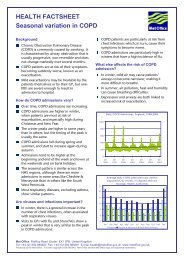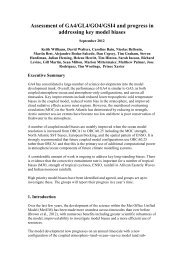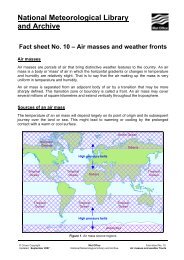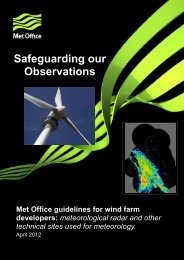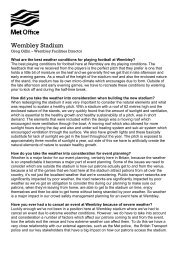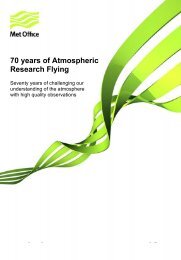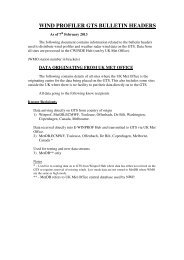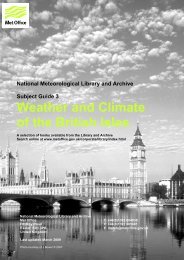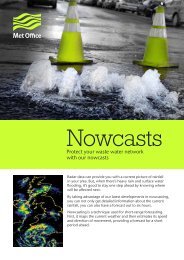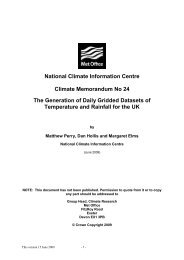Description and assessment of the OSTIA reanalysis. - Met Office
Description and assessment of the OSTIA reanalysis. - Met Office
Description and assessment of the OSTIA reanalysis. - Met Office
Create successful ePaper yourself
Turn your PDF publications into a flip-book with our unique Google optimized e-Paper software.
(b) AVHRR observations minus background merid<br />
ional Hovmuller plot<br />
(a) ATSR-1 observations minus background meridional<br />
Hovmuller plot<br />
Figure 4.4: Meridionally averaged observation minus background Hovmuller plot for ATSR-1 observations<br />
(Left) <strong>and</strong> AVHRR Pathfinder observations (right).<br />
<strong>the</strong> ATSR-1 data than in 4.4(b) for <strong>the</strong> AVHRR data is a greater cold bias at high latitudes which is<br />
discussed shortly.<br />
During this time period <strong>the</strong> <strong>OSTIA</strong> <strong>reanalysis</strong> system attempts to correct <strong>the</strong> biases in both <strong>the</strong><br />
ATSR-1 <strong>and</strong> <strong>the</strong> AVHRR Pathfinder data using <strong>the</strong> in-situ data as a reference data set as described<br />
in section 3.4. Figures 4.3(c) <strong>and</strong> 4.3(d) show <strong>the</strong> average bias correction applied to <strong>the</strong> satellite<br />
observations from both sources during <strong>the</strong> <strong>OSTIA</strong> <strong>reanalysis</strong> assimilation during August 1991.<br />
Comparison <strong>of</strong> <strong>the</strong>se figures with figures 4.3(a) <strong>and</strong> 4.3(b) illustrates that <strong>the</strong> correction applied<br />
to <strong>the</strong> data resembles <strong>the</strong> spatial pattern <strong>of</strong> <strong>the</strong> bias observed <strong>and</strong> discussed previously. This is<br />
consistent throughout <strong>the</strong> period <strong>of</strong> <strong>the</strong> ATSR-1 data. The spatial coverage <strong>of</strong> <strong>the</strong> in-situ reference<br />
data set is particularly poor at high sou<strong>the</strong>rn latituides during this time period. The bias correction<br />
methodology is dependent on a significant number <strong>of</strong> match-ups being found betwen <strong>the</strong> observations<br />
<strong>and</strong> <strong>the</strong> reference data set which cannot be achieved in <strong>the</strong> Sou<strong>the</strong>rn Ocean during this time<br />
period, thus <strong>the</strong> validity <strong>of</strong> <strong>the</strong> bias corrections applied at this time in <strong>the</strong> Sou<strong>the</strong>rn Ocean <strong>and</strong> in<br />
o<strong>the</strong>r undersampled regions may be in doubt. This problem may be exacerbated by possible cold<br />
biases in <strong>the</strong> ATSR-1 data due to cloud contamination (Merchant, 2010, pers. comm.).<br />
© c Crown Copyright 2011 49




